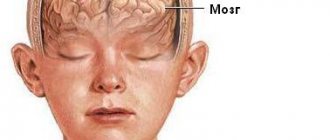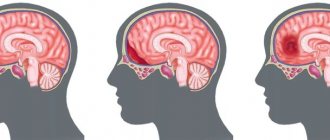Causes and risk factors
Concussion can have several causes. The conditions for the appearance of pathology in everyday life, at work and on the battlefield differ significantly from each other, so approaches to diagnosis and treatment will differ from each other.
Explosion is one of the common causes of concussion
Table: causes of contusion in different conditions
| Military reasons | Production reasons | Household reasons |
| Use of firearms | Powerful vibrations of various equipment | Gas cylinder explosion |
| Military grenade explosion | Explosions of flammable substances in workshops | Fall from a great height |
| Prolonged stay in military equipment while it is moving | Pressure drops when diving to depth | Sudden change in atmospheric pressure |
| Violation of safety regulations during military operations | Collapse of sand or rocks | Physical and mechanical impact on the body (accident) |
| Depressurization of a submarine or aircraft | Excessive noise levels and harsh sounds in production | Strong impact on the water surface |
Table: causes of contusion damage to individual organs
| Brain | Auditory and vestibular apparatus | Visual apparatus | Spinal column |
| Traumatic brain injury | A sharp blow to the ears | Impact with force that deforms the eyeball | Traumatic damage to the bones of the spine |
| Infectious and inflammatory processes in brain tissue, leading to its enlargement | Mechanical rupture of the eardrum | Compression of the eyeballs | Infectious processes in the bones of the spine (syphilis, tuberculosis) |
| Dropsy of the brain | Accumulation of fluid in the middle ear cavity | A sharp increase in intraocular pressure | Changes in atmospheric pressure |
| Violation of the biological and chemical composition of cerebrospinal fluid | Infectious and inflammatory processes in the sinuses of the skull | Impaired blood supply to the eyeball and optic nerve | Bone compression and deformation |
Risk factors
Like any traumatic injury, concussion has certain risk factors. By reducing their number, the possibility of pathology occurring is minimized. But unfortunately, most of them cannot be completely eliminated.
Main risk factors:
- engaging in dangerous sports;
- work in physical and chemical production;
- work related to the effects of vibration on the body;
- long stay in the zone of radiation contamination;
- work with high-power radiation;
- violation of safety regulations when handling weapons;
- violation of the rules of movement in military transport;
- staying in the blast wave zone;
- close proximity to a military training ground where weapons are tested.
Symptoms of concussion
It’s hard for many to imagine how a person can get a general body bruise. The fact is that when exposed to a powerful blast wave, the air comes into contact with the body with enormous force. Despite the fact that this impulse is uniform, each organ reacts to it differently. Most often, the brain and nervous system are damaged, which leads to serious consequences of concussion.
With mild exposure, a person may lose consciousness. This state can last for several seconds or several hours, after which all body functions are completely restored. Actually, no other symptoms are observed with such a concussion. If the exposure is too intense, the person may die on the spot. The consequences of a severe concussion can be expressed both by corresponding symptoms and by breathing problems and the functioning of the cardiovascular system. Sometimes there is a complete stop of breathing after a concussion and death. In most cases, disorders in the body of moderate and severe severity are combined with bone fractures, ruptures and bruises of internal organs and concussion.
What it is?
An eye contusion is an injury to the visual organ as a result of exposure to heavy blunt objects or intense mechanical force.
ICD-10 code
Eye contusion according to ICD-10 (international classification of diseases) is designated by code S05 and is one of the most dangerous injuries to the eyeball.
S05 Trauma to the eye and orbit Classification:
- S05.0 Conjunctival trauma and corneal abrasion without mention of a foreign body.
- S05.1 Contusion of the eyeball and orbital tissues.
- S05.2 Laceration of the eye with prolapse or loss of intraocular tissue.
- S05.3 Laceration of the eye without prolapse or loss of intraocular tissue.
- S05.4 Penetrating wound of the orbit with or without the presence of a foreign body.
- S05.5 Penetrating wound of the eyeball with a foreign body.
- S05.6 Penetrating wound of the eyeball without a foreign body.
- S05.7 Eyeball avulsion.
- S05.8 Other injuries of the eye and orbit.
- S05.9 Injury to unspecified part of the eye and orbit.
Diagnosis of the condition
To distinguish a concussion from a regular bruise, concussion or shock, it is necessary to carry out a wide range of diagnostic measures. Since it is not possible to interview the patient at first after the injury, a brief life history is collected from his closest relatives or friends, and the circumstances of the injury and the first medical measures taken are collected from eyewitnesses of the incident.
After the patient returns to consciousness, the doctor collects complaints and checks the organs of vision, hearing, smell and the patient’s ability to move his limbs. Based on the data obtained, a preliminary diagnosis is made.
Conversation with the patient is an important stage in collecting anamnesis.
Instrumental diagnostic methods
To establish a final diagnosis, specialists resort to modern research methods. They allow us to clarify the severity of the lesion and suggest possible outcomes.
The main methods of instrumental examination are:
- X-ray examination: will determine whether the integrity of the bones (skull, limbs, spine) has been compromised;
- Ultrasound diagnostics: will show the presence or absence of hematomas and soft tissue damage;
- electroencephalography: is a recording of the bioelectric potentials of the brain, with its help you can track the decrease and increase in the activity of a particular segment, which will allow you to find out the location of the damage;
- computed tomography or magnetic resonance imaging: will allow you to differentiate a concussion from a bruise, fracture or concussion;
- visual acuity examination and intraocular pressure measurement: will help make a diagnosis of visual contusion;
- hardware diagnostics of hearing acuity using audiometry: will show the degree of damage to the hearing organs;
- static and dynamic functional tests: will allow you to determine damage to the balance organs;
- microscopic examination of the cellular composition of the cerebrospinal fluid using a puncture: will make it possible to diagnose a spinal cord contusion.
First aid
In case of a mild contusion, the victim can cope with first aid on his own. The main thing is not to harm yourself. Therefore, it is prohibited to do the following:
- rub the eye;
- press on the eyelids;
- touch the injured eye with unwashed hands;
- treat damaged tissues with iodine or brilliant green;
- wash the eye in case of penetrating wound or deep damage;
- apply a cotton swab to the eye in case of penetrating injury.
In case of minor damage, apply a compressive bandage to the eye and place an ice pack inside the bandage. This must be done immediately after the injury so that hematomas and swelling do not spread to healthy tissue. After this, you need to go to the emergency room so that the damage is examined by a doctor.
First aid includes the following procedures:
- applying a bandage to protect from light;
- the use of Albucid drops to prevent microbial infection;
- taking sedatives to relieve stress;
- taking analgesics to relieve pain;
- stopping bleeding (if necessary);
- exclusion of sudden movements, pushing, jumping, running.
A bandage is applied to the open wound to isolate the damaged tissue from contact with air and the environment.
If a chemical substance (fungicides, agrochemicals, etc.) gets on the eyeball, you need to rinse it with a large volume of water and go to the emergency room.
Consequences for the eyeball
The consequences of an eye contusion can be very serious, including complete loss of vision, without the possibility of recovery.
Corneas
Damage to the cornea is the most common consequence of eyeball contusion. Signs of such defects are erosion of varying depths and areas. They have the ability to change their size upward within a week.
The first indicators of corneal injury include:
- decreased visual acuity;
- unpleasant sensitivity to light;
- uncontrolled production of tears;
- feeling that something is in the eye;
- blepharospasms.
Blurred vision occurs if the central zones of the cornea are eroded. When the stroma is damaged, visual acuity noticeably decreases. Destruction of the endothelium leads to edema in the depths of the stroma, and opacification of the cornea in the form of stripes and latticework leads to the penetration of purulent composition into other areas of the stroma.
Important! In particularly severe cases of corneal defect, 3rd degree eye contusion may develop. At this stage, the eye becomes cloudy and takes on a gray tint.
Lens
Eye contusion is often a consequence of traumatic cataract. The reason is caused by clouding of the lens due to a change in its location (luxation). Due to the fact that moisture enters through microcracks in the capsule of the anterior chamber of the eye, the volume of fluid may increase with visible bruising.
Fibers in the form of a swollen mass fill the entire volume of the capsule if its cracks are significant. Sometimes the fibers block part of the anterior chamber, increasing pressure inside the eye and causing glaucoma. Lens luxation is characterized by deformation of the anterior chamber and displacement of the iris. The lens itself takes the form of a drop filled with fat.
Retina
Retinal injury is one of the most severe types of damage.
With minor injury, the structure of the eye and vision quickly and independently resume their functions. If it comes to severe cases (for example, 2nd degree contusion of the eyeball), then visual acuity is significantly reduced, and bleeding may develop:
- preretinal;
- retinal;
- subretinal.
Treatment
The victim needs to be hospitalized urgently. Treatment will be prescribed taking into account the severity of the brain injury:
- Compress on the head.
- Peace and quiet.
- Stopping bleeding.
- Therapy using medications such as antibiotics, anti-inflammatory drugs.
- Surgery.
- Physical education of therapeutic type.
- Immunotherapy.
- Help from a psychotherapist and psychologist.
- Speech restoration (conducting special classes).
During the recovery process, the patient undergoes sanatorium treatment. He gets massages and takes soothing baths. It is not recommended to stay in stuffy rooms or in the sun. It is also better to avoid working in noisy places.
Why is it impossible to self-medicate concussion?
You can only make the situation worse. First aid should be provided and an ambulance should be called. You should not try to carry out this or that procedure, as this may lead to unforeseen consequences.











